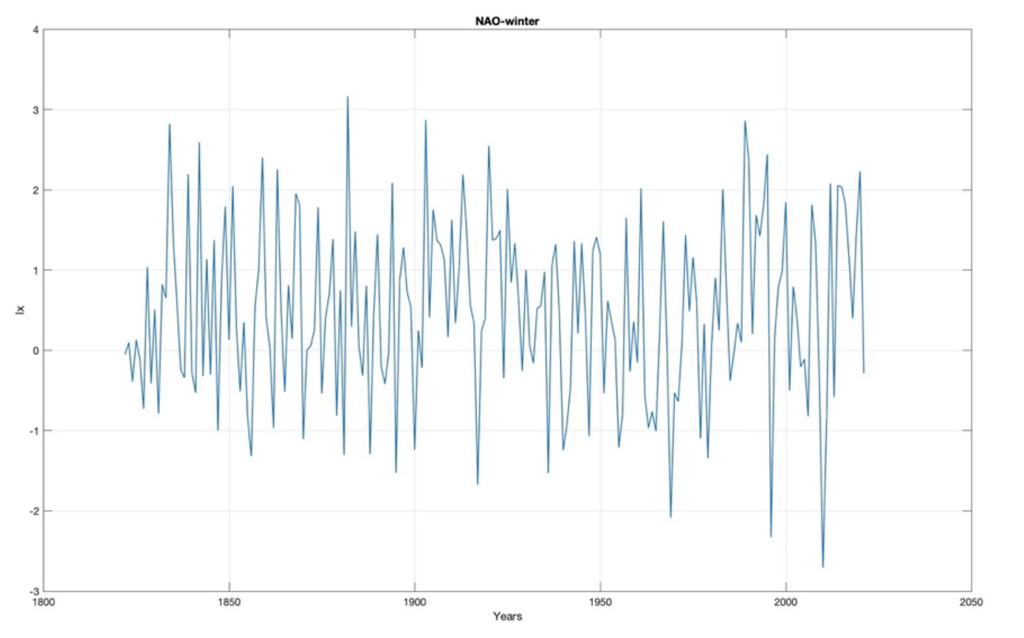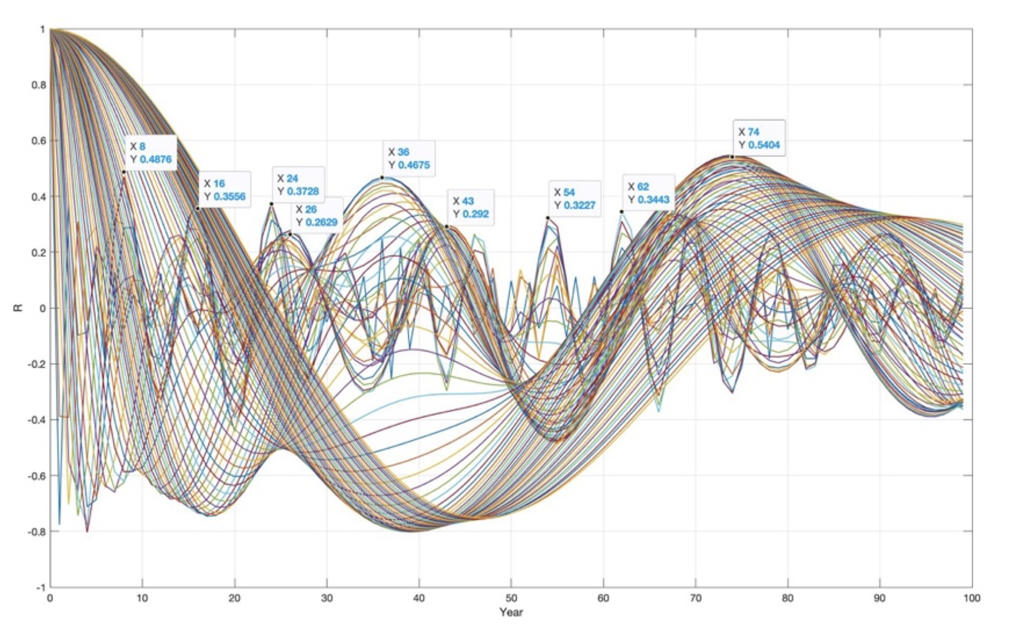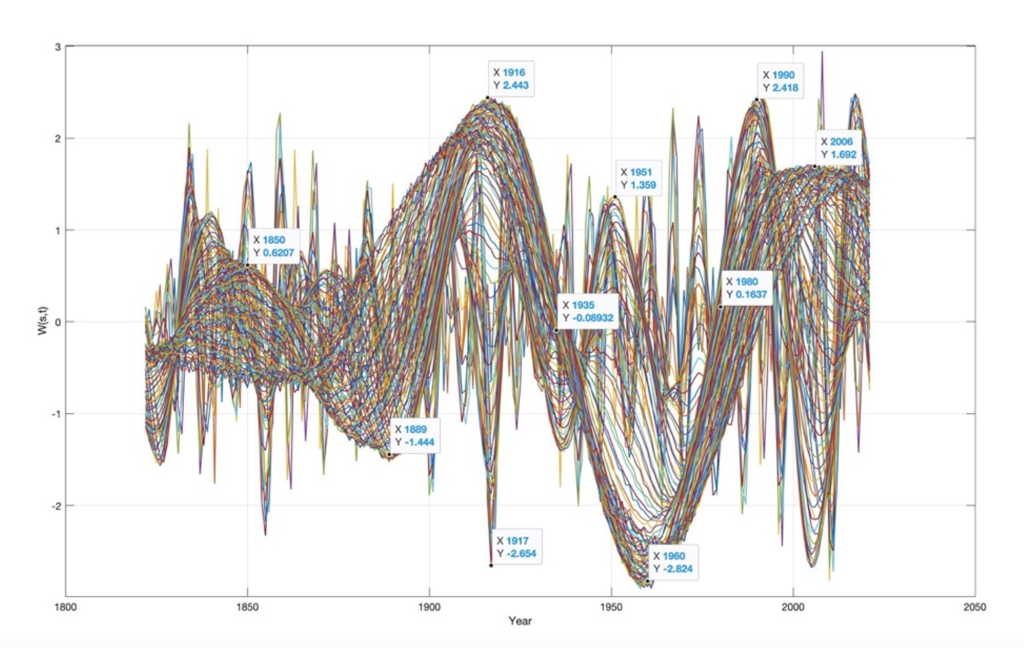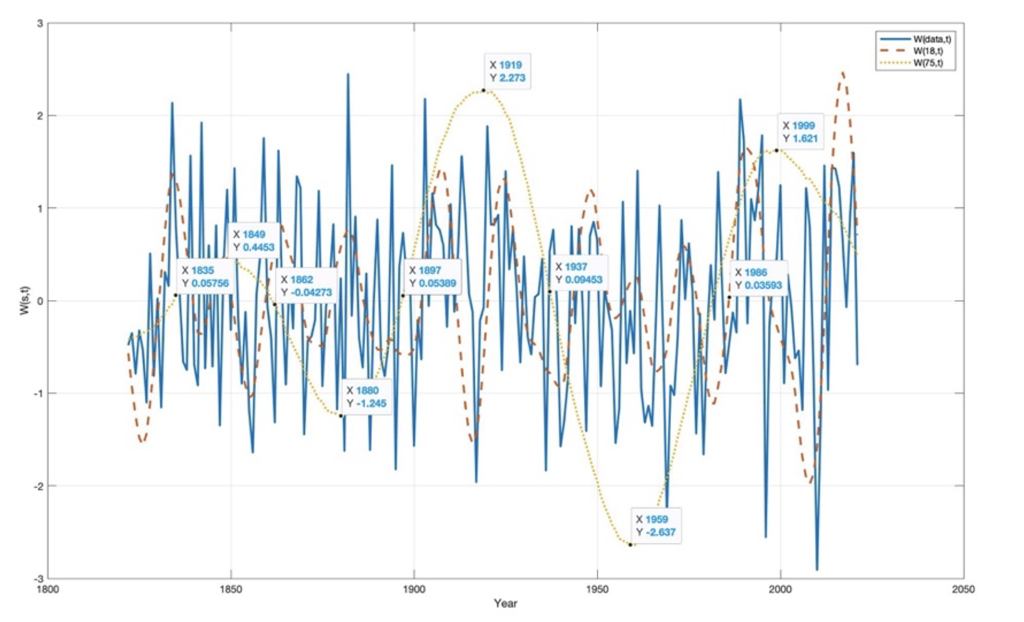NAO index signature reveals an upcoming colder climate period.

Figure 1. The NAO winter index from 1822 to 2022.
The Figure 1 show the NAO winter index from 1822 to 2017. The NAO winter (December thru March) index is based on the difference of normalized air pressure between Portugal and Iceland. The North Atlantic Oscillation (NAO) index is a well-known weather indicator in Europa.
- Positive values are associated with low atmospheric pressure difference between Iceland and Azores.
- A positive NAO index causes warm winds from west, mild winters, and more rain in summers.
- Negative values are associated with high atmospheric pressure difference between Iceland and Azores.
- A negative NAO index causes more cold winds from north, colder winters, and less rain full summers.
The NAO index signature

Figure 2. Autocorrelations of the wavelet specter (Figure 3).
The NAO winter index signature is revealed by computing the periods spectrum (periods and phase). A computed wavelet spectrum reveals period phase-relations. Autocorrelations of the wavelet spectrum, reveals the stationary periods.
Figure 2 shows the autocorrelations of the NAO index wavelet spectrum from 1822 to 2022. The computed autocorrelations have the correlations R = [0.5, 0.5, 0.6] to the stationary periods T = [8, 36, 74] (yr.). The 8-year period has a coincidence to the 8.8-year lunar perigean tide. The long periods [36, 74] has a coincidence to the lunar nodal tide signature periods [2, 3]18.6 (yr.). The signature [2, 3]18.6 has a coincidence to North Atlantic Water temperature signature and Arctic Ice extent signature periods [3]. The lunar nodal cycle is controlled by the moon.

Figure 3. Wavelet spectrum of the NAO winter index for the years t = 1822 to 2022.
Figure 3 shows the computed NAO index wavelet spectrum. The NAO wavelet spectrum covers a period of 200 years from 1822 to 2022. The dominant long period in the wavelet specter, confirms a 74-year period in the NAO index.

Figure 4. The NAO winter index and the 74-year wavelet period for t = 1822 to 2022.
Figure 4 shows the NAO winter index and the identified 74-year wavelet period. The computed 74-year period has amplitude and phase shifts at the years: [(-1.2, 1880), (+0, 1897), (2.3, 1919), (+0, 1937), (-2.6, 1959), (-0, 1986), (1.6, 1999)].
Upcoming events
A perfect stationary 74.4-year lunar driven NAO period has phase shifts (max/+0/min/-0/max) at the years: (max, 1986+18.6 = 2004.6), (+0, 2004.6+18.6=2023.2), (min, 2041.8), (-0, 2060.4), (max, 2079). The computed upcoming 74.4-year phase shifts reveals:
- NAO index variations had a maximum approximately the year 2005
- NAO index variations move into more negative states from 2023 to 2060.
- NAO index signature reveals an upcoming colder climate period.
The NAO-index variability is not well understood. This investigation confirm that the NAO winter index is controlled by a spectrum of lunar nodal periods. The Lunar nodal period signature is identified in North Atlantic temperature variations, Arctic ice extent, Arctic Ocean water circulation and Earth axis rotation [3]. The NAO index signature periods are related to North Atlantic temperature at Arctic ice extent. A possible source of NAO is that Arctic ice extent behave as an isolator between warm sea water and cold air temperature [2], [3].
References

The climate shift of 1976-78 is well expressed in atmospheric data. At the surface it is expressed in the temperature of the water in the tropics. However, it is expressed to the most dramatic extent in the temperature of the air in the stratosphere over the Antarctic continent, to the greatest degree at the highest elevations. The signature of that change propagated to the Arctic.
The signature is evident in the temperature of the air at the level of the jetstream and below the tropopause across the entire globe. You can pick this data up here: https://psl.noaa.gov/cgi-bin/data/timeseries/timeseries1.pl
It is probable that the effect on surface climate is due to a diminution in the density if upper air ice cloud cover.